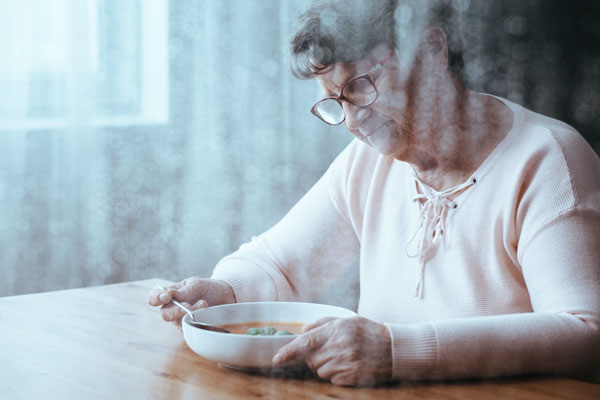Senior citizens are sometimes referred to as the “hidden hungry.” One in 11 seniors face hunger each day, yet too often they are forgotten. Many live alone and face mobility issues that prevent them from accessing the nutritious food they so desperately need. Others would rather stay silent than ask for help. They are all struggling to get by instead of enjoying their golden years.

Many of our older citizens struggle with hunger and food insecurity . Since the start of the recession in 2007, the number of seniors facing hunger has increased by 65%. Nearly 3.8 million of older Americans are unsure of where they will find their next meal.
The problem is only expected to get worse as our population ages. Fifty-eight million Americans are 60 or older. By 2060, that number is expected to double.
What Causes Food Insecurity Amongst Senior Ctitizens?
Although Americans are remaining in the workforce longer, their earnings tend to decline as they get older. Diminished incomes, or losing a job altogether, combined with rising housing costs and health care bills has left millions of seniors at or below the poverty line.
On top of that, the average household has little to no retirement savings. In fact, “1/3 of senior households has no money left over each month or is in debt after meeting essential expenses.” They live on fixed incomes and rely on programs like Social Security and Supplemental Security Income. The average monthly payment for both of those assistance programs comes out to around $2,000 per month combined. “Twenty-one percent of elderly married couples and 43% of unmarried persons rely on Social Security for 90% or more of their income.”
Because of their limited income, millions of seniors are forced to make difficult choices. According to Feeding America’s research, although food insecurity in communities of the elderly have lowered since the Covid-19 pandemic, they still remain higher than pre-Great Depression rates. Covid-19 was a tragic time for all and unfortunately, when it came to food insecurity, the elderly took a hard hit. Many older adults were unable to have access to food during this time.
Some groups of senior citizens are more likely to experience food insecurity than others. Seniors who live in the south are far more likely to be food insecure. The reason for this is that nine of the 10 states with the highest rates of food insecurity are in the south. 17% of African American seniors and 18% of Hispanic seniors are food insecure, compared to just 7% of caucasian seniors. One-third of food insecure senior citizens have a disability. Furthermore, nearly 1 in 5 seniors living with grandchildren are food insecure.
The Effects of Food Insecurity
With most seniors having specific nutrition needs, in addition to having increased risk for a variety of chronic health conditions, lacking access to wholesome foods can have many harmful health effects. It has been found that seniors who experience food insecurity are more likely to suffer from conditions such as diabetes, asthma, and high blood pressure.

Studies have also shown that the constant worry and uncertainty that comes along with food insecurity can have an impact on the psychological well-being of people. Senior citizens who are food insecure are also 60% more likely to experience depression, 53% more likely to report a heart attack, and 40% more likely to develop congestive heart failure.
Lack of Assistance to Food Assistance Programs
The Supplemental Nutrition Assistance Program (SNAP) could be an additional source of support, but only 42% of eligible seniors participate in the program. As a comparison, roughly 85% of eligible, non-elderly adults take advantage of the benefit. Feelings of stigma or guilt, confusing applications, and barriers related to mobility are all reasons why the participation rate is so low among senior citizens.
What can we fo to help?
Clearly, we need to do more to prevent older Americans from going to bed hungry. Feeding America, the Food Research and Action Center, and the National Council on Aging all stress the importance of enrolling more seniors in SNAP. That can be accomplished through greater outreach and simplifying the application process. As the population gets older, the number of food insecure seniors will only increase, so federal nutrition programs, like SNAP, will have to be strengthened to accommodate the need.
You can take action today by contacting your elected officials. Tell them that you demand they protect our senior citizens from going hungry.
Millions of senior citizens, however, need our help today. The growing need is putting an increased strain on hunger relief organizations all across the country. Let’s work together to host a food drive and support your local food bank or pantry.
